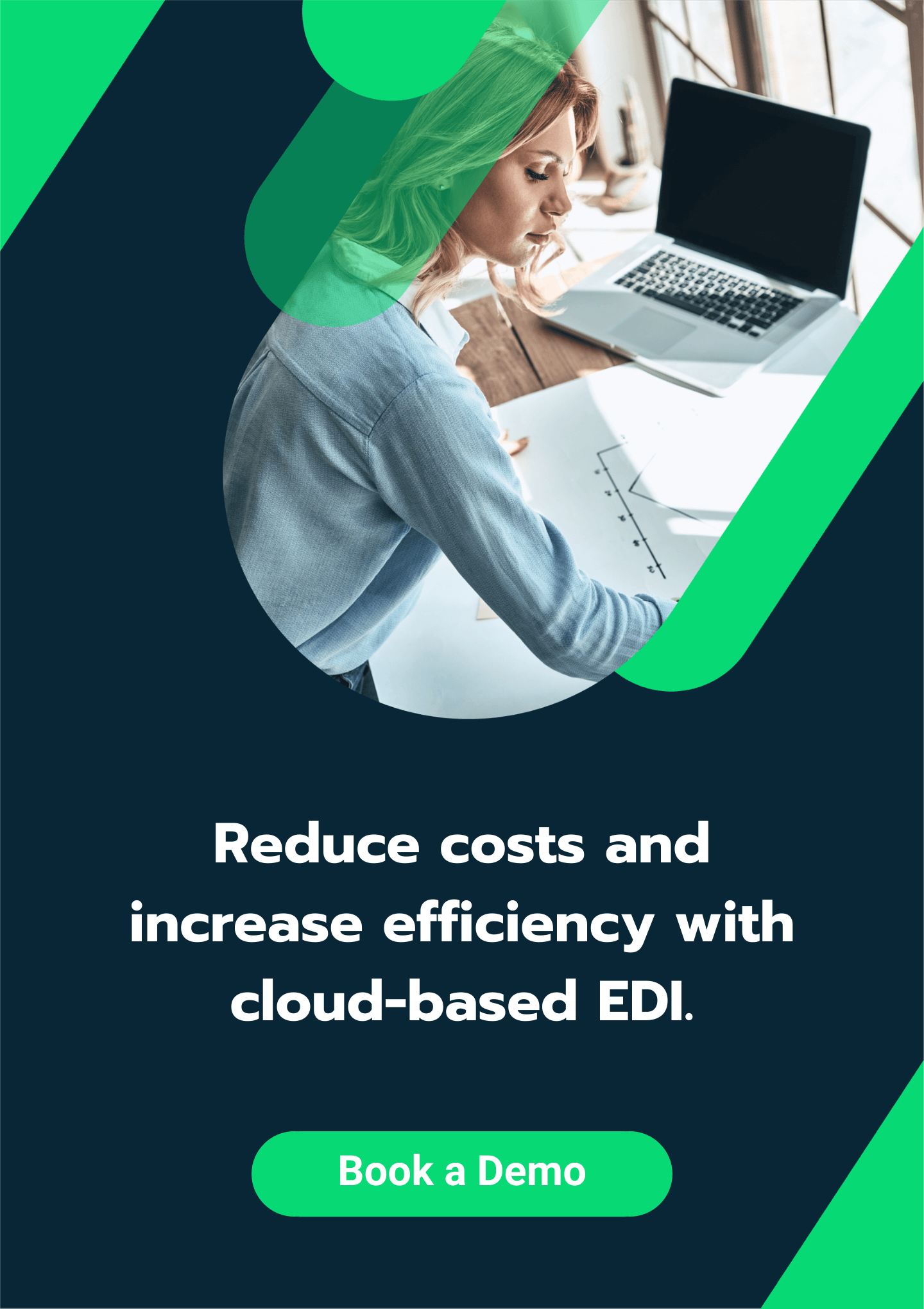5 Most Common EDI Implementation Issues and How to Solve Them
If you’re considering an EDI (Electronic Data Interchange) rollout in 2021, you aren’t alone. Last year’s disruption left a lot of businesses pondering ways to improve their supply chain management. EDI is a critical tool that brings stability, visibility and optimisation. But only if done right. An effective EDI implementation requires planning. You need to:
- Select the right type of EDI solution.
- Ensure compatibility with your supply chain partners.
- Integrate data across your organisation.
- Manage security and costs.
- Align outcomes with business requirements and goals.
To help, we’ve put to use our three-plus decades of EDI experience at Data Interchange to compile a list of the five most common mistakes we’ve seen in action — and provided answers about how you can avoid them. We can fix EDI implementations that have gone wrong. But making sure that you get started on the right foot will improve ROI and ensure an effective outcome from day one. Let’s get started.
1. Underestimating supply chain complexity
EDI is a great way to overcome complexity and improve supply chain management. But underestimating your supply chain can derail a project from the start. Remember, “EDI” isn’t just one thing — or really a “thing” at all. It’s a methodology encompassing many sets of standards and transmission protocols. Your solution needs to align with the requirements of your business, and all of the businesses within your supply chain.
Globalisation has resulted in larger supply chains — magnifying both the challenges and benefits of EDI implementation. A rigid EDI system won’t be able to connect all of these stakeholders, and could leave you struggling with manual inputs and ad-hoc procedures that will undermine the entire point of your investment.
Strategies to help:
The type of EDI you deploy has a large impact on your ability to manage complexity. Managed services and cloud-based software can resolve and simplify a lot of the integration challenges — more on that in the next section.
In addition to industry- and region-specific standards (for example, VDA in the German Automotive Industry), there are three common standards you will definitely need to incorporate:
- UN/EDIFACT (United Nations/Electronic Data Interchange for Administration, Commerce and Transport): The only truly international set of standards, EDIFACT was developed by the UN in 1987 and is widely used.
- ASC X12 (Accredited Standards Committee X12): The dominant standard in North America and often referred to as “ANSI X12”. Chartered by the American National Standards Institute in 1979, the ASC maintains the X12 standards along with a growing number of XML schemas specifically for health care, insurance, government transportation and finance.
- GS1 EDI: Part of the overall GS1 system, GS1 is effectively a subset of EDIFACT that is popular within global supply chains — and supported as a modern development by organisations like McKinsey.
You also need to make sure that your system is able to accommodate a number of different transmission protocols. These include repurposed protocols such as FTP, SFTP, and HTTP, and EDI-specific protocols like OFTP, X.400 and AS2.
High transaction volumes, global partners and relationships that span multiple industries are all likely complicating factors that need to be planned around. But complexity can take many forms. For example, don’t underestimate the challenge of onboarding a supplier with little experience using EDI.
Pro tip: Since it’s adoption by Walmart in 2002, AS2 has continued to increase in adoption and popularity as an EDI protocol.
2. Picking the wrong type of EDI
“EDI types” are different approaches to exchanging information, and each has pros and cons. Choosing which one is right for your business is a critical early decision that will impact your entire experience with EDI. The main types of EDI are:
- Direct EDI (Point-to-Point EDI): Direct EDI establishes a single connection between two businesses. This provides the most control, is generally on-premise, and can be cost-effective if executed appropriately. However, it also requires the most in-house expertise to effectively deploy, and can make it hard to accommodate change and/or multiple protocols and standards.
- EDI via VAN: A VAN (or Value Added Network) is a private network established by a third-party that is used to exchange documents. This adds flexibility and outsources the maintenance of an effective solution.
- Web EDI: Web EDI simplifies the exchange of information by replicating paper-based documents with web forms. This provides a simple way for users to input information that is then converted into an EDI message. This type of solution is most often provided by a third-party, and is particularly useful for businesses (either your business, or businesses within your supply chain) that have limited EDI experience.
Each of the above strategies can be executed through self-service options or as a managed service. Managed services are a great shortcut to sidestepping implementation issues, and can help deliver seamless outcomes long-term. Particularly if you want to build a hybrid solution that deploys multiple EDI strategies, managed services can significantly simplify that process for your business.
Suggested reading: 10 Things to Look for in an EDI Managed Service Provider.
Strategies to help:
Modern EDI developments have focused on simplifying engagement with EDI. Web EDI is a great example of this, and the simplicity of using cloud-based tools (both from a management and user standpoint) make them critical to effective EDI implementation and long-term execution. If cloud-based tools and Web EDI capabilities are not delivered “as-a-service”, they are important to build in-house.
Fundamentally, if you don’t have the right skills in-house, a direct EDI solution is not the right choice. And don’t forget about your supply chain relationships. Your solution not only needs to match the technical requirements of your suppliers and customers, but also their EDI expertise and maturity. In every EDI solution, you should look for intuitive dashboards that filter reporting, simple upload tools that enable inexperienced users to submit data, and fully integrated solutions that minimise or remove manual steps.
Pro tip: Building a hybrid solution that combines elements of multiple types of EDI is a good choice that can improve the flexibility of your supply chain relationships.
3. Corrupted or incomplete data
Getting started with EDI will put your existing data to the test, and requires putting systems in place that will simplify the creation of data over time. A lot of EDI formats, for example EDIFACT, were not meant for humans to read or understand. That means catching and fixing errors is challenging and requires specific (and increasingly uncommon) skill sets. Even where possible, manual error detection is time-consuming and expensive — and can still result in transaction errors.
Strategies to help:
Bad data often originates at the order level. Typically, you will see incorrect prices, out-of-stock items and/or duplicate orders. The benefit of EDI on data quality is that you’re directly integrating systems, removing human error. But that data needs to be correct in the first place. The best place to check and improve the quality of your data is at the source — your ERP, or your trading partner’s. It’s then valuable to have error detection tools within your EDI system.
Pro tip: By striving for a 100% EDI adoption rate, you can minimise the number of manual inputs within your supply chain. In turn, this will minimise data errors.
4. Forgetting about security
EDI brings you into closer contact with your supply chain partners. But by sharing information, you also expose elements of your internal system to those partners — and vice versa. International relationships can further complicate matters by adding different legal frameworks, privacy and data protection rules, and cultural expectations.
Strategies to help:
The security risks posed by EDI are partially physiological. Realistically, you were already sharing a lot of the information transferred by EDI with your supply chain partners — you are now just doing so in a new format. However, you need to ensure that encrypted transfer protocols are used, and proper data storage is undertaken on both ends. That means openly discussing security policies with your partners, and making sure everyone is comfortable with a set of best practices.
It’s also important to understand the sensitivity of your data. For example, order data isn’t very sensitive at all. Whereas, invoices potentially reveal commercially sensitive information. However, if you are managing very sensitive data, like healthcare information, more stringent precautions need to be taken.
Pro tip: If all of your data is stored in a VAN, or another hosted solution, there are fewer moving parts that you need to consider to deliver a secure outcome. However, you do need to check the security certifications of your VAN — for example, ISO 27001 accreditations.
5. Spiralling costs
Ultimately, EDI is about cost savings. An effective EDI solution will streamline your logistics and supply chain relationships — delivering process, workflow and cost efficiencies. But getting started can be expensive, and if you are plagued by implementation issues, a negative side effect will be additional costs. At the very least, this will increase your payback period.
Possible additional costs can be incurred at near every stage:
- Development of EDI skills, organisational structure and processes.
- Building an EDI solution or finding an EDI provider.
- Digitisation of data and EDI integration across your business.
- Rollout of EDI to trading partners.
You also face reputation costs if your EDI implementation doesn’t go well. A lot of manufacturers will penalise suppliers if they get EDI wrong because of its impact on production lines.
Strategies to help:
Avoiding cost overrun comes down to planning. You need a clear understanding of your goals, in-house skills and supply chain relationships. You then need to make choices that will deliver a system aligned with the right outcomes.
Internally managed systems have the potential to generate the lowest direct costs. However, if that system fails, or requires significant changes or additions to your organisation, the benefits of an in-house solution can quickly disappear. EDI via VAN and/or Web-EDI are invaluable assets for a business looking to create a more flexible solution and simplify elements of implementation.
Pro tip: Managed services can help you get started, or deliver a long-term managed solution without leading to spiralling costs. Read about our managed services and consulting service if you want to learn more.
Don’t forget about the bigger picture
Critical to effective EDI implementation is a clear set of goals and a solid understanding of your supply chain. Be honest about your in-house expertise and remember to consider the requirements of your suppliers and customers — their technical requirements, and their level of EDI expertise.
Fundamentally, you should look to simplify the use, management and flexibility of your EDI system at every turn. You need a hybrid-outcome that is able to accommodate the full spectrum of formats, standards and protocols, and be used by people with limited EDI experience. Likely, that means using a combination of EDI via VAN, Web-EDI tools and managed services.
Lastly, stay focused on the business outcomes that EDI can deliver. Part of that benefit is supply chain efficiency. But a better understanding of your supply chain relationships can upgrade your strategic and tactical decision-making, helping you become a more supply chain centered business.























































































































